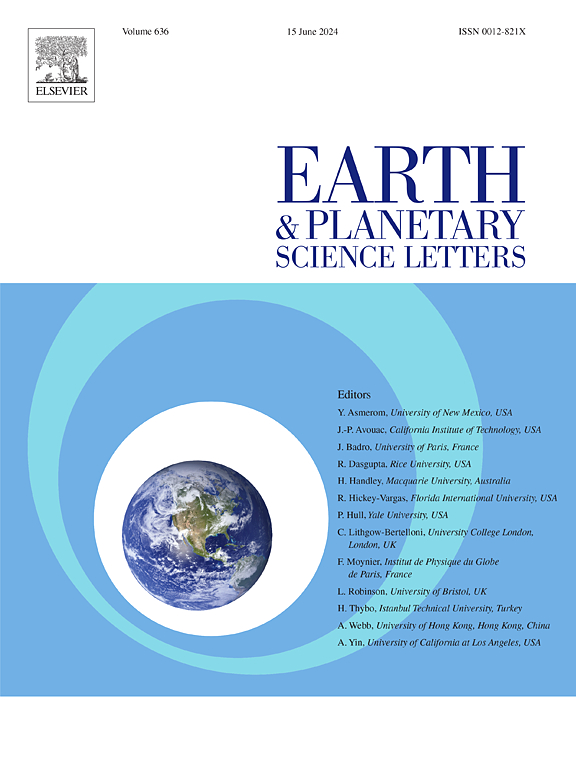近代上升流系统中的沉积汞循环
IF 4.8
1区 地球科学
Q1 GEOCHEMISTRY & GEOPHYSICS
引用次数: 0
摘要
汞(Hg)是人为扰动的主要指标,但洪堡和本格拉洋流系统现代上升流沉积物中汞的数据库很少。汞有自然和人为来源,存在于不同物种中,最终掩埋前的再循环过程使汞积累的解释复杂化。在这里,我们提供了来自秘鲁、智利和纳米比亚的210Pb年代沉积物的总汞、Al、Zr、有机碳和Pb(一种更直接、研究更充分的人为指标)的数据,这些数据来自它们各自的氧最小带(OMZs)内部和以下。几乎所有的沉积物在上~ 30 cm处都显示出汞的上核富集,这表明汞的来源类似于铅。20世纪80年代初,秘鲁(800µg kg-1)的汞富集峰值最高,其次是智利(150µg kg-1)和纳米比亚(80µg kg-1)。这种差异可能是由于秘鲁有大量的工业和前工业采矿场地,而这些场地在智利不太重要,在纳米比亚基本上没有。汞也在海洋表层沉积物中积累,这支持了先前深海汞出口的迹象,而铅只在海洋表层沉积物中积累。秘鲁沉积物中的汞富集可忽略不计的过量铅含量表明,自工业化前时代(公元1900年以前)以来,冶金汞的投入。相比之下,在纳米比亚沿海的一个地点可检测到人为汞,而纳米比亚其他沉积物中的汞可能是自然的,而不是人为的。我们的数据表明,最近的omz内部和以下的环境都是汞积累的热点。本文章由计算机程序翻译,如有差异,请以英文原文为准。
Sedimentary mercury cycling in recent upwelling systems
Mercury (Hg) is a prime indicator of anthropogenic perturbations yet the database of Hg in modern upwelling sediments from the Humboldt and Benguela current systems is sparse. Mercury has natural and anthropogenic sources, occurs in different species, and recycling processes before final burial complicates the interpretation of Hg accumulation.
Here, we present data of total Hg along with Al, Zr, organic carbon and Pb (a more straightforward and well-studied anthropogenic indicator) for 210Pb-dated sediments from Peru, Chile and Namibia from within and below their respective oxygen minimum zones (OMZs). Almost all sediments exhibit upcore enrichments of Hg in the upper ∼ 30 cm suggesting an anthropogenic source for Hg, similar to Pb. Peak Hg enrichments are highest off Peru (800 µg kg-1) in the early 1980s followed by less pronounced maxima off Chile (150 µg kg-1) and Namibia (80 µg kg-1). This difference is likely due to a high number of industrial and pre-industrial mining sites in Peru, which is less important in Chile and essentially missing in Namibia. Mercury also accumulates in sediments below OMZs supporting previous indications of abyssal Hg exports while Pb only accumulates in OMZ sediments.
Mercury enrichments in Peruvian sediments that have negligible excess Pb contents suggest metallurgic Hg inputs since pre-industrial times (before CE 1900). By contrast, anthropogenic Hg is detectable at one coastal Namibian site, while Hg in the other Namibian sediments may be natural rather than anthropogenic. Our data suggest that both environments within and below recent OMZs are Hg accumulation hotspots.
求助全文
通过发布文献求助,成功后即可免费获取论文全文。
去求助
来源期刊

Earth and Planetary Science Letters
地学-地球化学与地球物理
CiteScore
10.30
自引率
5.70%
发文量
475
审稿时长
2.8 months
期刊介绍:
Earth and Planetary Science Letters (EPSL) is a leading journal for researchers across the entire Earth and planetary sciences community. It publishes concise, exciting, high-impact articles ("Letters") of broad interest. Its focus is on physical and chemical processes, the evolution and general properties of the Earth and planets - from their deep interiors to their atmospheres. EPSL also includes a Frontiers section, featuring invited high-profile synthesis articles by leading experts on timely topics to bring cutting-edge research to the wider community.
 求助内容:
求助内容: 应助结果提醒方式:
应助结果提醒方式:


